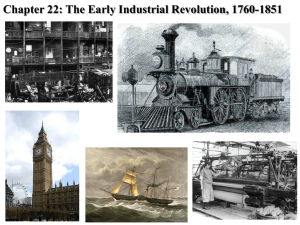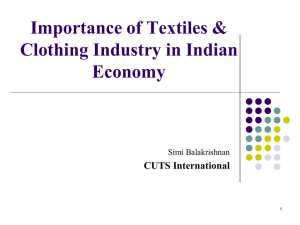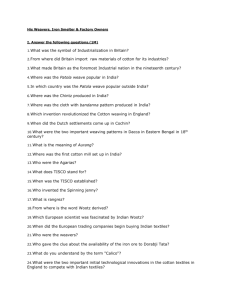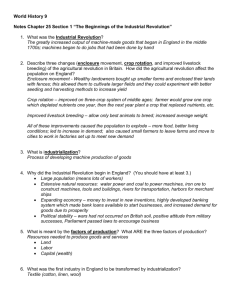Made in America? The New World, the Old, and the Industrial
advertisement
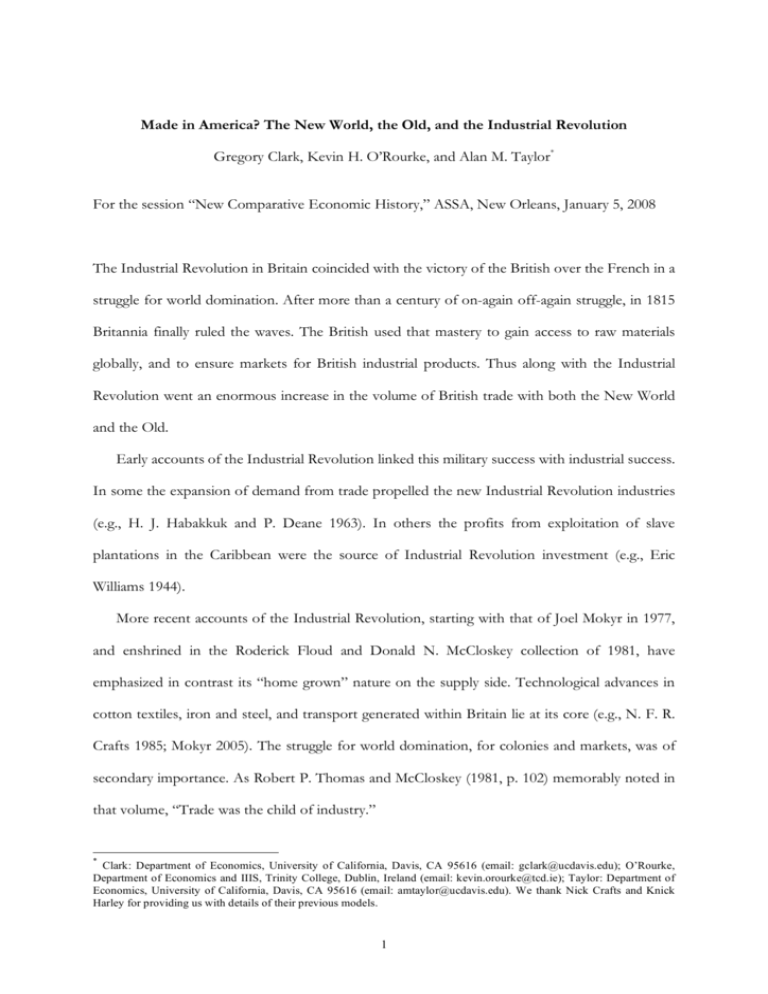
Made in America? The New World, the Old, and the Industrial Revolution Gregory Clark, Kevin H. O’Rourke, and Alan M. Taylor* For the session “New Comparative Economic History,” ASSA, New Orleans, January 5, 2008 The Industrial Revolution in Britain coincided with the victory of the British over the French in a struggle for world domination. After more than a century of on-again off-again struggle, in 1815 Britannia finally ruled the waves. The British used that mastery to gain access to raw materials globally, and to ensure markets for British industrial products. Thus along with the Industrial Revolution went an enormous increase in the volume of British trade with both the New World and the Old. Early accounts of the Industrial Revolution linked this military success with industrial success. In some the expansion of demand from trade propelled the new Industrial Revolution industries (e.g., H. J. Habakkuk and P. Deane 1963). In others the profits from exploitation of slave plantations in the Caribbean were the source of Industrial Revolution investment (e.g., Eric Williams 1944). More recent accounts of the Industrial Revolution, starting with that of Joel Mokyr in 1977, and enshrined in the Roderick Floud and Donald N. McCloskey collection of 1981, have emphasized in contrast its “home grown” nature on the supply side. Technological advances in cotton textiles, iron and steel, and transport generated within Britain lie at its core (e.g., N. F. R. Crafts 1985; Mokyr 2005). The struggle for world domination, for colonies and markets, was of secondary importance. As Robert P. Thomas and McCloskey (1981, p. 102) memorably noted in that volume, “Trade was the child of industry.” * Clark: Department of Economics, University of California, Davis, CA 95616 (email: gclark@ucdavis.edu); O’Rourke, Department of Economics and IIIS, Trinity College, Dublin, Ireland (email: kevin.orourke@tcd.ie); Taylor: Department of Economics, University of California, Davis, CA 95616 (email: amtaylor@ucdavis.edu). We thank Nick Crafts and Knick Harley for providing us with details of their previous models. 1 This consensus was in turn challenged by Kenneth Pomeranz (2000) in The Great Divergence. In what has been dubbed his “coal and colonies” interpretation of the Industrial Revolution, one of the key differences explaining why Britain and not China had an Industrial Revolution in 1800 was that Britain had access to the raw materials of the New World, while China did not. This paper sets out to test, with a formal CGE model, the role of trade with the New World, and trade itself, in explaining the growth of productivity and income in Britain in the Industrial Revolution era. We find, to our surprise, that the New World was only very modestly important, even by the 1850s. Had the Americas not existed, or not been discovered, the effects on TFP and income growth would have been perceptible, but the Industrial Revolution would have looked much as it does to us today. There were ready substitutes for the cotton, sugar, corn and timber of the New World in Eastern Europe, the Near East and South Asia. However, had all trade barriers been substantial—if, say, a victorious France cut off Britain’s access to European, African and Asian raw materials and markets—then the history of the Industrial Revolution Britain would have been very different. British incomes per person, instead of rising by 45% between the 1760s and 1850s would have risen by a mere 5%. The TFP growth rate, already a modest 0.4% per year, would have fallen to 0.22% per year. The magnitude, scale and transforming power of the Industrial Revolution lay in its unification of technological advance with the military power that generated easy British access to the markets of Europe, the Americas, the Near East and the Far East. As Ronald Findlay and Kevin O’Rourke emphasize in Power and Plenty (2007), early trade was not just the consequence of comparative advantage, but comparative advantage married to the musket and the cannon. It must be noted, however, that Britain’s trading partners gained along with Britain from the forced opening up of trade. A substantial share of the TFP gain witnessed in Britain over these years was exported in the form of cheaper manufactures to the rest of the world (Gregory Clark 2007a). 2 I. The Model We ask what the British economy would have looked like before and after the Industrial Revolution under counterfactual conditions where trading opportunities are restricted with the North America (including the Caribbean) or with the rest of the world. We could use a simple Britain-only model and impose counterfactual levels of trade, but as Nancy L. Stokey (2001) notes this approach is limited; absent detailed disaggregation it says nothing about cotton textiles and absent other regions and the terms-of-trade it says nothing about income and welfare. Our preferred tool is a three-region model of the world economy, for two benchmark periods, 1760–9 and 1850–9, roughly corresponding to the start and end of the British Industrial Revolution. The model extends the two-region Industrial Revolution models developed by Crafts and Knick Harley (Harley, 1993; Harley and Crafts, 2000), but it is calibrated for two different periods and, for our purposes, provides a richer structure than either the Stokey or Crafts-Harley models. The computable general equilibrium model is fully described by two pieces of information. The first is an accounting matrix for each region describing for each sector the value of goods produced, imported, and exported—and hence the domestic demand for those goods—and also the cost structure (i.e., the inputs of primary factors and intermediate goods). The sectors are cotton textiles; other textiles; iron and steel; coal; agriculture; tropical raw materials; tropical food; and the rest of the economy. The factors are land, labor, and capital; all are mobile across sectors but region-specific. Labor and capital are used in all sectors, while land is used in agriculture, tropical raw materials, and tropical food. The intermediate inputs are: coal into iron and steel; agricultural products into other textiles and coal; and tropical raw materials into cotton textiles and other textiles (and, for the 1850s, into agriculture and the rest of the economy as well). A level of regional and sectoral aggregation must be chosen suitable for the questions at hand. The three regions are England (1760s) and later Britain (1850s), not including Ireland; North America (including the Caribbean); and the Rest of the World. Trade is assumed to be costless. As is common in the literature, we assume that goods produced in each region are imperfect 3 substitutes for each other, which allows us to have two-way trade in the model. International imports and exports for each commodity are thus broken down by source and destination. Not every good is produced in each region (tropical raw materials and tropical food are produced in North America and the Rest of the World, but not in Britain). The matrices in each region fully describe the static benchmark equilibrium, and are given in the appendix. The second item we need is a set of elasticities that fully describe the response of the model economy to perturbations. Production in each sector is modelled as a Leontief combination of intermediate inputs and a value added aggregate. Value added is in turn a CES aggregate of the primary factors used as inputs. The elasticities of substitution in each sector chosen to be similar to those used by Harley and Crafts (2000): we used elasticities of 1 (Cobb-Douglas) in cotton textiles, other textiles, iron and steel, coal, and the rest of the economy; and elasticities of 0.5 in agriculture, tropical raw materials, and tropical food. Consumption is modelled by assuming that a representative agent in each region is endowed with all primary factors of production in that region, and spends all her income on a composite utility good (the production of which can thus serve as a welfare indicator). The utility good is in turn produced by a CES utility function, with all eight commodities as inputs, and an elasticity of substitution of 0.5. The final model ingredients are what consumers consume, and what sectors use as intermediate inputs, is actually an aggregate of the different varieties of each commodity produced in each of the three regions. These Armington aggregates, one for each sector, are again CES combinations of the three varieties of the relevant commodity. Once again we chose values of the Armington elasticities of substitution for each commodity that were close to those used by Harley and Crafts: we used values of 5 for cotton textiles, iron and steel, and coal; 2 for ‘other textiles’ and the rest of the economy; and 100 for agriculture. The Armington elasticities for tropical raw materials and food are particularly important for the counterfactuals experiments we conducted, and we consider these separately below.1 1 Full details of the model are in the working paper version (Clark, O’Rourke, and Taylor 2008). 4 II. Calibration and Counterfactuals To setup the model we sourced data as follows. The total value of English/British expenditure and its composition across different goods was taken from Clark (2007b). Imports and exports of each type of good were then taken from Ralph Davis (1962, 1979). Thus, the value of the production of each good could then be inferred. We imposed zero production of both tropical goods in Britain. Next, based on our rough estimates of factor shares and intermediate costs shares we were able to compute the input-output structure and the value of payments to factors in each sector, and thus in the aggregate. Via the circular flow, these factor payments equal total expenditure. For simplicity, we adjusted the rest of the economy sector’s output and exports to impose balanced trade, although our results do not depend on this assumption. A different procedure was followed for the other two regions. For North America we assumed that final expenditure in each period on each good was a simple multiple of British expenditure, scaling by population relative to England/Britain, and thus assuming the same relative living standard (except that coal consumption was set equal to imports from Britain). For the Rest of the World we assumed that incomes per person relative to England were the same in the 1760s, and at 40% of the British level by the 1850s. In the rest of the world we imposed an assumed pattern of final consumption in each period, with the following weights for each sector, cotton textiles, 0.02, other textiles, 0.04, iron and steel, 0.01, coal, 0.001, temperate agriculture, 0.375, tropical agriculture, 0.375, rest of the economy, 0.18. Thomas Ellison’s discussion of cotton consumption per person in India in the 1850s suggests this is probably an underestimate of cotton and cotton goods production in the rest of the world, even though it implies that the cotton industry in the rest of the world was nearly 5 times as large as in England (Ellison, 1858, p. 73). Import and export data were then constructed using the Davis (1962, 1979) data for trade with England/Britain and some auxiliary data and assumptions.2 Table 1 shows the resulting In the 1760s case, we assume the Navigation Acts excluded direct trade between North America and the Rest of the World, and use Davis’s re-export data to estimate the bilateral trade pattern between North America and the Rest of the World. In the 1850s, the assumption is dropped, so we use Douglas Irwin’s North American trade data (Susan 2 5 estimated trade patterns in the 1760s and 1850s. From the consumption and trade patterns we infer production patterns and, assuming that input cost shares in each sector were like those in Britain, we infer payments to intermediates and to all factors. Once again, factor incomes are equal to expenditure by construction, and trade was forced to be balanced by adjusting the rest of the economy sector in each case. With the model set up we impose various counterfactual shocks and see how the model world economy would react. Our interest is in evaluating the hypothesis that the British Industrial Revolution depended crucially on international trade—either with North America, the Rest of the World, or both. To that end, we impose three different counterfactual shocks on the model: a. “No NA”: Reduce North American endowments by a factor of 20; b. “No ROW”: Reduce Rest of the World endowments by a factor of 20; c. “No NA/ROW”: Reduce both sets of endowments by a factor of 20; Note that we cannot entirely eliminate each region’s endowments since each region makes a differentiated product, whose price would be infinite were its supply to be reduced to zero, but these endowment shocks provide a reasonable estimate of the gains from trade to the British economy that would have been sacrificed had trade been made almost impossibly costly. The purpose of the three experiments is to gauge how vital a contribution trade with each region, and trade as a whole, made to the structural transformation and growth of the British economy. For example, the “No NA” shock permits us to grapple with the thesis of Pomeranz (2000) and see how critical New World supplies of raw cotton were to the rise of Lancashire. The “No ROW” shock allows us to see the importance of other major export markets for Lancashire’s cotton products, as well as the role played by alternative suppliers of raw cotton like Egypt and India. In the remainder of the paper we describe the results of these counterfactuals and how they pose a challenge to current interpretations of the Industrial Revolution. Carter et al. 2006) by good and by region, assuming that America’s import pattern from the Rest of the World was similar to Britain’s, and its export pattern to the Rest of the World was similar to its export pattern to Britain. 6 III. Results The results are given in Tables 2 and 3, but the intuition behind the results comes from the trade data in Table 1. Several differences between the two periods stand out. First, and most obviously, in the 1760s England was still a large net importer of cotton textiles from the rest of the world, which also exported textiles to North America. By the 1850s, Britain was a large net exporter of cotton textiles to both the other regions, thanks to the new spinning and weaving technologies of the Industrial Revolution. Second, in the 1760s England was paying for her imports of food and tropical products primarily with net exports of “other” goods, and of woollens and other textiles, although net exports of iron and steel, and some agricultural exports, also helped. By the 1850s, agricultural exports had essentially ceased, and exports of non-cotton textiles had declined in relative importance: cotton textiles and exports of “other” goods were now relatively speaking far more dominant. A third point to note is that in the 1760s, imports of tropical raw materials came predominantly from the rest of the world rather than from North America, while imports of tropical food came predominantly from North America. By the 1850s, imports of tropical raw materials from North America had considerably grown in relative importance, thanks to the boom in raw cotton exports, while the rest of the world was now more important than North America as a source of tropical food imports. Since this is a highly aggregated model, both “tropical raw materials” and “tropical food” cover a wide variety of goods from many regions of the world. From the British point of view, a crucial question, had trade with North America been rendered impossible, is how easy it would have been for the rest of the world to provide it with the raw cotton that was so crucial for the growing cotton textile industry. The experience of the early 1860s, when Brazil, Egypt and above all India sharply increased their exports to Britain in response to the “cotton famine” of that period, suggests that there would indeed have been a compensatory supply response from the rest of the world, although probably not a perfectly elastic one, since British industry did suffer during the cotton famine. In terms of our model, the issue boils down to the size of the Armington 7 elasticity of substitution between the tropical raw materials Britain was importing from North America and the rest of the world. We thus experimented with several values of this elasticity, as well as with the corresponding elasticity for tropical food, for while the elasticity of substitution between New World sugar and Asian pepper, say, might not have mattered for the fortunes of British industry, it might well have had an impact on British consumer welfare, in a counterfactual world in which Britain was prevented from trading with either of the two regions. In our benchmark specification, these elasticities are both set to 5, since these are the ‘upper end’ Armington elasticities used by Harley and Crafts, but we also tried lowering the elasticities to 2, and increasing them to 100 (which is equivalent to making the different varieties of these goods almost perfect substitutes). Table 2 gives the results of isolating England from its trading partners in the 1760s. Look first at the benchmark results in columns (1) to (3). The table presents outputs in each sector; prices in each sector; nominal factor prices; the price of the utility good, which is equivalent to a consumer price index; nominal household income; real factor prices and household income; and utility (i.e. the output of the sector producing the utility good: not surprisingly, this is identical to real household income). The most important point to make here is that, according to these results, preventing trade between England and North America would have had barely any effect on the English economy. Utility would have declined by less than 2%, although this aggregate impact masks a still modest real wage decline of 4.3%, a decline in real profits of 5.7%, and a rise in real land rents of 9.4%. Cotton textiles output would have gone down, as expected, but only barely: by just 1.1%, as compared with a decline in the output of other textiles of almost a tenth, the latter being due to the disappearance of North American markets. Removing the rest of the world from the equation would have had a much bigger effect (column 2), since it was a much bigger region. Strikingly, if trade between England and the rest of the world had been eliminated in the 1760s, this would have increased the size of the English cotton textile sector by a third, since as mentioned earlier England was still a net importer of 8 Indian cotton textiles. Similarly, English agriculture would have had to expand to replace the food previously imported from the rest of Europe, and as a result all other sectors would have had to contract, as resources were sucked away from them. Utility would have declined by somewhat less than previously (1.7%), but the distributional shifts would have been greater, since in the 1760s English imports of temperate climate agricultural products still came predominantly from Europe rather than from North America or other continents. Thus English landlords would have seen their incomes rise in real terms by over a quarter, while workers and capitalists would have seen their real incomes decline by 7.9% and 10.6% respectively. Not surprisingly, ‘eliminating’ both North America and the rest of the world would have had an even bigger impact on the traditional textile sector, cutting it by over a quarter. Cotton textiles production would have increased by a quarter, and agriculture by 14.5%. Landlords would have seen real rents increase by 44.9%, at the expense of real wages (down 13.9%) and real profits (down a fifth), but the aggregate utility effect would still have been surprisingly small (a decline of less than 4%). Finally, note that varying the two Armington elasticities mentioned above would have barely changed the results (compare columns 4 through 15 with columns 1 through 3). The results look very different for the 1850s (Table 3). Again, consider first the impact of cutting off trade with North America. In the benchmark case (column 1), this would have lowered cotton textiles output by 8%, and other textiles output by a tenth. Cotton textiles output would have declined both because of the disruption to raw cotton supplies, and because of the loss of markets. On balance, the former effect seems to be more important, since the real price of British cotton textiles increases in this simulation. Furthermore, when the elasticity of substitution between tropical raw materials from North America and the rest of the world is lowered to 2, implying that the rest of the world was less able to substitute for lost American raw cotton supplies, British cotton textiles output contracts by more (by almost 15% in column 4, and by almost 18% in column 10). On the other hand, if that elasticity is raised to 100, then the output only falls by 2% (column 13). Utility falls by between 1.6% and 3.6%, depending on the sizes of 9 Armington elasticities chosen, with larger elasticities naturally corresponding to lower welfare losses. While these are larger welfare effects than those documented in Table 2, they are still modest: the rest of the world could have filled in for a counterfactually missing North America, providing markets, raw materials and tropical food products, minimising the overall loss to the British economy. Once again, landlords would have gained by roughly 10% in real terms, at the expense of workers and capitalists. On the other hand, the welfare loss would have been much greater—over 10%—if it had been trade with the rest of the world, rather than North America, that had been eliminated (column 2). Cotton textiles output would have contracted by over a third, as the foreign markets upon which Lancashire was increasingly dependent vanished. (Note the difference with the results in Table 2: by the 1850s Britain was a net exporter of cotton textiles to India and the rest of the world, rather than a net importer.) Since the rest of the world mattered for the British cotton textiles industry more by providing markets than by providing raw cotton, it is not surprising that the Armington elasticities highlighted earlier are essentially irrelevant for this counterfactual experiment, as a glance across columns 5, 8, 11 and 14 will confirm. Consistent with Stokey (2001), the distributional effects of this shock are enormous, with real rents more than doubling, and real wages and profits declining by over a fifth. In terms of TFP performance, a decline of a third in the cotton textile sector would have lowered the economy-wide TFP growth rate by .06% per annum, or by 6% over the 1760s–1850s period. Finally, “eliminating” both of Britain’s trading partners would have had an even bigger effect on the economy, with utility falling by over 27%, a very large effect in a model without increasing returns or any other non-concavities. Cotton textiles output would have declined by almost three-fifths, implying a reduction in the economy-wide TFP growth rate of 0.11%, more than a quarter of the Industrial Revolution productivity growth rate, while real wages and profits would have declined by over a third. If we had been able to go further, and completely eliminate Britain’s trading partners, the effects on economy-wide welfare and textiles output would 10 obviously have been even greater. And ours may yet be a conservative estimate of hypothetical TFP losses, for if the dynamic cotton textiles sector had grown more slowly then the incentives to innovate (or even passive “learning by doing” opportunities) might have been scaled down too. IV. Conclusion We argue that colonies were not a necessary condition for the Industrial Revolution, nor was supply-side TFP growth sufficient. In Smithian terms, in the 19th-century global “division of labor” it was the “power of exchanging” that “gave occasion” to the British Industrial Revolution. The highly specialized British economy was extremely dependent on foreign trade by the 1850s, while the Thomas-McCloskey position seems more defensible for the earlier period of the 1760s. It is worth emphasising why the 1850s results are so different from the 1760s. This has nothing to do with model specification, since the model is identical in both cases (as are all the elasticities embedded in that model). Rather, very different results arise from the data fed into the model, which in turn reflect the profound shifts in the structure of the British economy over the course of the Industrial Revolution. First, unbalanced productivity growth meant that British autarkic relative prices diverged from those in the rest of the world, implying much larger gains from trade: the leading cotton textiles sector was now dependent on foreign markets for about 60% of its total sales. Second, British population growth meant that the island was now critically dependent on foreign agriculture for both food and raw materials needs, in turn implying that it needed to export manufactures to pay for these imports (Harley and Crafts 2000; Clark 2007a). As a famous Welsh economic historian put it, “How could this unprecedented swarming of people on a small, offshore island be made consistent with a rising standard of living? It was impossible on the fixed area of English cultivable land, whatever miracles English technological progress in agriculture might accomplish. The way out was for England (through a transportation revolution and international trade) to endow itself with the equivalent of a vast extension of its own land base” (Brinley Thomas 1985, p. 731). In that context, by the mid 19th century, the maintenance of an open international trading system was of vital strategic importance to Britain. 11 REFERENCES Carter, Susan B., Scott Sigmund Gartner, Michael R. Haines, Alan L. Olmstead, Richard Sutch, and Gavin Wright, eds. 2006. Historical Statistics of the United States, Earliest Times to the Present: Millennial Edition. New York: Cambridge University Press. Clark, Gregory. 2007a. “What Made Britannia Great? How Much of the Rise of Britain to World Dominance by 1850 does the Industrial Revolution Explain?” In The New Comparative Economic History: Essays in Honor of Jeffrey G. Williamson, ed. Timothy J. Hatton, Kevin H. O’Rourke, and Alan M. Taylor, 33–57. Cambridge, MA: MIT Press. Clark, Gregory. 2007b. “The Macroeconomic Aggregates for England, 1209–2004.” Working Paper, UC Davis. Clark, Gregory, Kevin H. O’Rourke, and Alan M. Taylor. 2008. “Made in America? The New World, the Old, and the Industrial Revolution.” NBER Working Paper, forthcoming. Crafts, N. F. R. 1985. British Economic Growth during the Industrial Revolution. Oxford: Oxford University Press. Crafts, N. F. R., and C. Knick Harley. 2000. “Simulating the Two Views of the British Industrial Revolution.” Journal of Economic History, 60(3): 819–84. Davis, Ralph. 1962. “English Foreign Trade, 1700–1774.” Economic History Review, 15(2): 285–303. Davis, Ralph. 1979. The Industrial Revolution and British Overseas Trade. Leicester: Leicester University Press. Deane, Phyllis, and W. A. Cole. 1967. British Economic Growth, 1688–1959. 2nd ed. Cambridge: Cambridge University Press. Ellison, Thomas. 1858. A Handbook of the Cotton Trade. London: Longman. Findlay, Ronald, and Kevin H. O’Rourke. 2007. Power and Plenty: Trade, War, and the World Economy in the Second Millennium. Princeton, NJ: Princeton University Press. Floud, Roderick, and Donald McCloskey, eds. 1981. The Economic History of Britain since 1700. 2 vols. Cambridge: Cambridge University Press. 12 Habakkuk, H. J., and P. Deane. 1963. “The Take-Off in Britain.” In The Economics of Take-Off into Sustained Growth, ed. W. W. Rostow, 63–82. London: Macmillan. Harley, C. Knick. 1993. “Reassessing the Industrial Revolution: A Macro View.” In The British Industrial Revolution: An Economic Perspective, ed. Joel Mokyr, 171–226. Boulder, CO: Westview Press. Harley, C. Knick, and N. F. R. Crafts. 2000. “Simulating the Two Views of the British Industrial Revolution.” Journal of Economic History 60(3): 819–841. Mokyr, Joel. 1977. “Demand vs. Supply in the Industrial Revolution.” Journal of Economic History 37(4): 981–1008. Mokyr, Joel. 2005. “The Intellectual Origins of Modern Economic Growth,” Journal of Economic History 65(2): 285–351. Pomeranz, Kenneth. 2000. The Great Divergence: China, Europe, and the Making of the Modern World Economy. Princeton, NJ: Princeton University Press. Stokey, Nancy L. 2001. “A Quantitative Model of the British Industrial Revolution, 1780–1850.” Carnegie-Rochester Conference Series on Public Policy, 55: 55–109. Thomas, Brinley. 1985. “Escaping from Constraints: The Industrial Revolution in a Malthusian Context.” Journal of Interdisciplinary History 15(4): 729–753. Thomas, Robert P., and Donald N. McCloskey. 1981. “Overseas Trade and Empire 1700–1860.” In The Economic History of Britain since 1700, ed. Roderick Floud and Donald N. McCloskey, 87–102. Cambridge: Cambridge University Press. Williams, Eric. 1944. Capitalism and Slavery. Chapel Hill, NC: University of North Carolina Press. 13 Table 1. Trade flows, 1760s and 1850s (£ millions) 1760 ROW to GB GB to ROW NAM to GB GB to NAM ROW to NAM NAM to ROW 1850s ROW to GB GB to ROW NAM to GB GB to NAM ROW to NAM NAM to ROW Cotton textiles 0.697 0.045 0.000 0.176 0.085 0.000 Other textiles 1.766 3.053 0.000 1.962 0.495 0.000 Iron & Steel 0.471 0.826 0.010 0.372 0.000 0.001 Cotton textiles 0.000 33.889 0.000 5.691 0.000 0.000 Other textiles 8.695 11.471 0.008 6.829 1.441 0.008 Iron & Steel 0.000 14.710 0.000 4.866 0.000 0.000 Coal 0.000 0.321 0.000 0.012 0.000 0.000 Coal 0.000 5.534 0.000 0.291 0.000 0.000 Source: See text and Clark, O’Rourke, and Taylor (2008). 14 Agriculture 2.729 0.422 0.602 0.150 0.210 0.048 Rest of Economy 0.117 3.892 0.001 1.504 0.016 0.000 Tropical raw mat. 1.139 0.000 0.255 0.000 0.001 0.020 Tropical food 1.047 0.000 3.901 0.000 0.165 0.310 Agriculture 67.268 0.000 13.014 0.000 15.140 13.545 Rest of Economy 16.677 82.677 2.705 11.330 28.782 2.815 Tropical raw mat. 25.120 0.000 19.845 0.000 8.998 20.655 Tropical food 15.297 0.000 8.659 0.000 6.899 9.012 Table 2. Counterfactual results, 1760s Elasticities: Outputs Cotton textiles Other textiles Iron and steel Coal Agriculture Other Prices Cotton textiles Other textiles Iron and steel Coal Agriculture Other Wages Profits Rents Price of utility Nominal income Real wage Real profits Real rents Real income Utility (1) (2) (3) (4) (5) (6) (7) (8) (9) (10) (11) (12) (13) (14) (15) TRM=5; TFOOD=5 TRM=2; TFOOD=5 TRM=5; TFOOD=2 TRM=2; TFOOD=2 TRM=100; TFOOD=100 BM No NAM No ROW Neither No NAM No ROW Neither No NAM No ROW Neither No NAM No ROW Neither No NAM No ROW Neither 100 100 100 100 100 100 98.9 90.7 107.4 100.7 103.7 98.3 133.4 86.8 83.5 92.3 108.8 93.8 125.6 73.9 65.3 92.7 114.5 90.9 98.6 90.7 107.6 100.7 103.7 98.3 133.3 86.8 83.5 92.3 108.8 93.8 125.4 73.9 65.4 92.7 114.5 90.9 101.6 90.9 108.9 100.1 103.8 98.1 133.3 86.8 83.5 92.3 108.8 93.8 128 74.1 66.1 92.2 114.5 90.8 100.7 90.8 109.4 100.1 103.8 98.1 133.3 86.8 83.5 92.3 108.8 93.8 127.6 74 66.3 92.2 114.5 90.8 98.7 90.9 106.2 101 103.5 98.5 134.2 87.2 83.9 92.3 108.6 93.9 124.5 73.9 64.4 93 114.4 91 100 100 100 100 100 100 100 100 100 100 100 100 100 100 100 100 94.3 94.9 92.8 93.5 99.7 93.2 93.6 92.2 107 97.8 96.0 95.7 94.3 109.4 98.1 98.1 82.6 84.1 79.8 81.3 94.7 80.5 81.3 78.9 111.6 88.3 86.8 92.1 89.4 126.4 98.3 98.3 75.2 77.6 70.4 72.8 94.7 71.9 73.3 68.6 123.3 85.1 82.3 86.1 80.6 144.9 96.7 96.7 94.5 94.9 92.7 93.5 99.7 93.1 93.5 92.2 107.1 97.8 95.9 95.6 94.3 109.5 98.1 98.1 82.6 84.1 79.8 81.3 94.7 80.5 81.3 78.8 111.6 88.3 86.8 92.1 89.2 126.4 98.3 98.3 75.4 77.6 70.4 72.8 94.7 71.8 73.3 68.6 123.3 85.1 82.2 86.1 80.6 144.9 96.6 96.6 94.5 94.9 92.8 93.5 99.7 93.1 93.5 92.3 107.1 99.3 95.9 94.2 93.0 107.9 96.6 96.6 82.6 84.1 79.8 81.3 94.7 80.5 81.3 78.8 111.5 88.3 86.8 92.1 89.2 126.3 98.3 98.3 75.4 77.7 70.5 72.9 94.7 71.9 73.3 68.7 123.4 86.1 82.3 85.1 79.8 143.3 95.6 95.6 95 95.1 92.7 93.4 99.7 93 93.4 92.2 107.2 99.5 95.9 93.9 92.7 107.7 96.4 96.4 82.6 84.1 79.8 81.2 94.7 80.5 81.2 78.8 111.5 88.3 86.8 92.0 89.2 126.3 98.3 98.3 75.8 77.8 70.5 72.8 94.7 71.9 73.3 68.7 123.4 86.3 82.3 84.9 79.6 143.0 95.4 95.4 93.9 94.6 92.7 93.4 99.3 93.1 93.5 92.2 106.3 96.6 95.8 96.8 95.4 110.0 99.2 99.1 83.1 84.7 80.5 82 95.2 81.2 81.9 79.6 111.8 89 87.4 92.0 89.4 125.6 98.2 98.3 74.8 77.4 70.4 72.8 94.5 71.8 73.3 68.6 123 84.2 82.2 87.1 81.5 146.1 97.6 97.6 Notes: BM = Benchmark. No NAM = North American endowments set to 5% of actual. No ROW = rest of world endowments set to 5% of actual. Neither = North American and rest of world endowments set to 5% of actual. TRM = Armington elasticity of substitution between North American and rest of world tropical raw materials. TFOOD = Armington elasticity of substitution between North American and rest of world tropical food. 15 Table 3. Counterfactual results, 1850s Elasticities: BM Outputs Cotton textiles Other textiles Iron and steel Coal Agriculture Other Prices Cotton textiles Other textiles Iron and steel Coal Agriculture Other Wages Profits Rents Price of utility Nominal income Real wage Real profits Real rents Real income Utility (1) (2) (3) TRM=5; TFOOD=5 No NAM No ROW Neither (4) (5) (6) (7) (8) (9) (10) (11) (12) (13) (14) (15) TRM=2; TFOOD=5 TRM=5; TFOOD=2 TRM=2; TFOOD=2 TRM=100; TFOOD=100 No NAM No ROW Neither No NAM No ROW Neither No NAM No ROW Neither No NAM No ROW Neither 100 100 100 100 100 100 92 90.1 99.8 101.4 104.2 100.4 65.8 90 115.4 88.1 130.7 87.3 41.3 74.2 112.8 79.3 123.3 99.1 85.4 89.5 101.5 101.5 104.4 100.8 65.7 90 115.4 88.1 130.7 87.3 41.3 74.2 112.9 79.3 123.3 99.1 90.9 90 100.2 101.4 104.3 100.4 65.8 90 115.4 88.1 130.7 87.3 41.3 74.2 112.8 79.3 123.3 99.1 82.2 89.2 103 101.4 104.6 100.9 65.7 90 115.4 88 130.7 87.3 41.2 74.2 112.9 79.3 123.3 99.1 98 90.5 98.5 101.4 103.9 100 66.4 90.1 115.4 88.1 130.7 87.3 41.6 74.3 112.6 79.4 123.4 99 100 100 100 100 100 100 100 100 100 100 100 100 100 100 100 100 100.4 96.8 94.5 94.2 100.1 94.1 94.3 93 107.9 97.4 95.1 96.8 95.5 110.8 97.6 97.7 81.4 76.1 67.2 63 101.2 61.7 61.3 60.5 167.8 79 71.0 77.6 76.6 212.4 89.9 89.8 61.9 31.5 20.7 19.8 29.6 20.8 19.6 18.7 41.3 29.5 21.3 66.4 63.4 140.0 72.3 72.4 104.4 97.4 93.9 93.6 100 93.5 93.7 92.3 108.1 97.5 94.6 96.1 94.7 110.9 97.0 97 81.5 76.2 67.2 63 101.2 61.7 61.3 60.5 167.8 79 71.0 77.6 76.6 212.4 89.9 89.8 62 31.5 20.7 19.8 29.7 20.8 19.6 18.7 41.3 29.5 21.3 66.4 63.4 140.0 72.3 72.4 101 96.9 94.4 94.1 100.1 94 94.1 92.9 108 97.5 95.0 96.5 95.3 110.8 97.4 97.4 81.4 76.1 67.2 63 101.2 61.7 61.3 60.5 167.8 79 71.0 77.6 76.6 212.4 89.9 89.8 62 31.5 20.7 19.8 29.6 20.8 19.6 18.7 41.3 29.5 21.3 66.4 63.4 140.0 72.3 72.4 106.7 97.8 93.7 93.3 100 93.4 93.4 92.1 108.3 97.9 94.3 95.4 94.1 110.6 96.4 96.4 81.5 76.2 67.2 63 101.2 61.7 61.3 60.5 167.8 79 71.0 77.6 76.6 212.4 89.9 89.8 62 31.5 20.7 19.8 29.7 20.8 19.6 18.7 41.3 29.5 21.3 66.4 63.4 140.0 72.4 72.4 97.2 96.5 95.1 94.8 100.1 94.6 94.8 93.7 107.4 97.1 95.6 97.6 96.5 110.6 98.5 98.4 80.5 75.9 67.2 63 101.1 61.6 61.2 60.5 167.6 78.8 70.9 77.7 76.8 212.7 90.0 90 60.5 30.9 20.4 19.5 29.2 20.4 19.3 18.4 40.8 29 21.0 66.6 63.4 140.7 72.5 72.6 Notes: BM = Benchmark. No NAM = North American endowments set to 5% of actual. No ROW = rest of world endowments set to 5% of actual. Neither = North American and rest of world endowments set to 5% of actual. TRM = Armington elasticity of substitution between North American and rest of world tropical raw materials. TFOOD = Armington elasticity of substitution between North American and rest of world tropical food. 16 Appendix: Input-output matrices A. 1760s ENGLAND Cotton Other Iron & Coal Agricul- Rest of Tropical Tropical Labour Capital Rent textiles textiles Steel ture Economy raw mat. food L K R Cotton tex 1.4 -0.19 -0.605 -0.605 0 Other tex 14.88 -3.15 -0.751 -5.4895 -5.4895 0 Iron + Steel 1.57 -0.19 -0.4554 -0.9246 0 Coal 3.41 -0.04 -1.78 -1.47 -0.12 Agriculture 38.9 -14.7 -5.7 -18.5 Rest of economy 35.101 -24.571 -10.53 0 Import 0.697 1.766 0.481 0 3.331 0.118 1.394 4.948 Total final 2.097 16.646 2.051 3.22 39.041 35.219 0.453 4.948 Cons 1.876 11.631 0.853 2.887 38.469 29.823 0.453 4.948 Exports 0.221 5.015 1.198 0.333 0.572 5.396 0 0 REST OF Cotton WORLD textiles Cotton tex 134.4 Other tex Iron + Steel Coal Agriculture Rest of economy Trop raw material Trop food Import 0.045 Total final 134.5 Cons 133.7 Exports 0.782 Other Iron & Coal Agricul- Rest of Tropical Tropical Labour Capital Rent textiles Steel ture Economy raw mat. food L K R -18.2426 -81.323 -34.853 0 132.89 -28.132 -6.70701 -68.636 -29.415 0 41.44 -5.0152 -25.498 -10.928 0 0 0 0 0 1706.64 -682.66 -341.33 -683 800.7743 -560.54 -240.23 0 26.06929 -10.428 -5.2139 -10.4 1671.92 -668.77 -334.38 -669 3.053 0.827 0.321 0.46984 3.892079 0.020265 0.31002 135.94 42.27 0.321 1673.96 804.6664 1.14 1672.23 133.68 41.8 0.321 1671.02 804.5334 0 1671.02 2.261 0.471 0 2.939 0.133 1.14 1.212 NORTH Cotton AMERICA textiles Cotton tex 1.615 Other tex Iron + Steel Coal Agriculture Rest of economy Trop raw material Trop food Import 0.261 Total final 1.876 Cons 1.876 Exports 0 Other Iron & Coal Agricul- Rest of Tropical Tropical Labour Capital Rent textiles Steel ture Economy raw mat. food L K R -0.21918 -0.9771 -0.4187 0 9.174 -1.9421 -0.46302 -4.7382 -2.0307 0 0.492 -0.3443 -0.1475 0 0 0 0 0 43.5759 -17.43 -8.7152 -17.4 28.30408 -19.813 -8.4912 0 1.40946 -0.5638 -0.2819 -0.56 8.99402 -3.5976 -1.7988 -3.6 2.457 0.372 0.012 0.36 1.52 0.001 0.165 11.631 0.864 0.012 41.9938 29.82408 0.728265 9.15902 11.631 0.853 0.012 41.344 29.823 0.453 4.948 0 0.011 0 0.64984 0.001079 0.275265 4.21102 Note: Negative entries denote inputs. Source: See text and Clark, O’Rourke, and Taylor (2008). 17 A. 1850s BRITAIN Cotton Other Iron & Coal Agricul- Rest of Tropical Tropical textiles textiles Steel ture Economy raw mat. food Cotton tex 67.81 -31.6 Other tex 60.413 -15.822 -6.261 Iron + Steel 69.38 -11 Coal 37.13 -0.7798 Agriculture 123.792 -2.58 Rest of economy 290.673 -4.524 Imports 0 8.7031 0 0 80.282 19.382 44.965 23.9562 Total final 67.81 69.116 69.38 26.13 187.472 310.055 0 23.9562 Cons 28.23 50.816 49.8 20.31 187.472 216.0481 0 23.9562 Exports 39.58 18.3 19.58 5.825 0 94.00694 0 0 Labour Capital -18.105 -19.165 -19.265 -21.054 -49.392 -200.3 Rent -18.105 0 -19.165 0 -39.114 0 -14.11 -1.19 -18.9 -52.9 -85.845 0 REST OF Cotton WORLD textiles Cotton tex 228.5 Other tex Iron + Steel Coal Agriculture Rest of economy Trop raw material Trop food Imports 33.89 Total final 262.4 Cons 262.4 Exports 0 Other Iron & Coal Agricul- Rest of Tropical Tropical Labour Capital Rent textiles Steel ture Economy raw mat. food -106.473 -85.404 -36.602 0 523.39 -137.08 -54.2427 -232.45 -99.621 0 116.5 -18.467 -68.605 -29.402 0 7.585 -5.3092 -2.2754 0 5143.8 -2057.5 -1028.8 -2058 2308.156 -1615.7 -692.45 0 174.1781 -69.671 -34.836 -69.7 4932.57 -1973 -986.51 -1973 11.479 14.71 5.534 13.5452 85.49235 20.655 9.01243 534.87 131.2 13.12 5001.8 2393.648 34.1176 4941.59 524.73 131.2 13.12 4919.39 2348.189 0 4919.39 10.136 0 0 82.4078 45.45945 34.1176 22.1966 NORTH Cotton AMERICA textiles Cotton tex 48.24 Other tex Iron + Steel Coal Agriculture Rest of economy Trop raw material Trop food Imports 5.691 Total final 53.93 Cons 53.93 Export 0 Other Iron & Coal Agricul- Rest of Tropical Tropical Labour Capital Rent textiles Steel ture Economy raw mat. food -22.4799 -12.88 -12.88 0 88.825 -23.264 -9.20553 -28.178 -28.178 0 90.28 -14.313 -25.068 -50.896 0 0 0 0 0 407.142 -162.86 -81.428 -163 378.1452 -264.7 -113.44 0 63.18783 -25.275 -12.638 -25.3 56.5379 -22.615 -11.308 -22.6 8.27 4.866 0.291 15.1398 40.11245 8.997602 6.89936 97.095 95.14 0.291 384.705 418.2577 40.5 63.4373 97.078 95.14 38.79 358.145 412.7373 0 45.7659 0.0163 0 0 26.5592 5.520408 40.5 17.6714 Note: Negative entries denote inputs. Source: See text and Clark, O’Rourke, and Taylor (2008). 18

